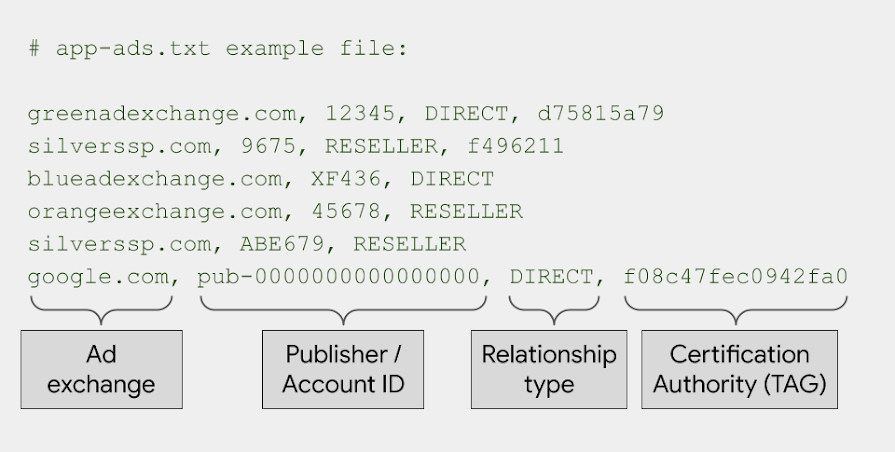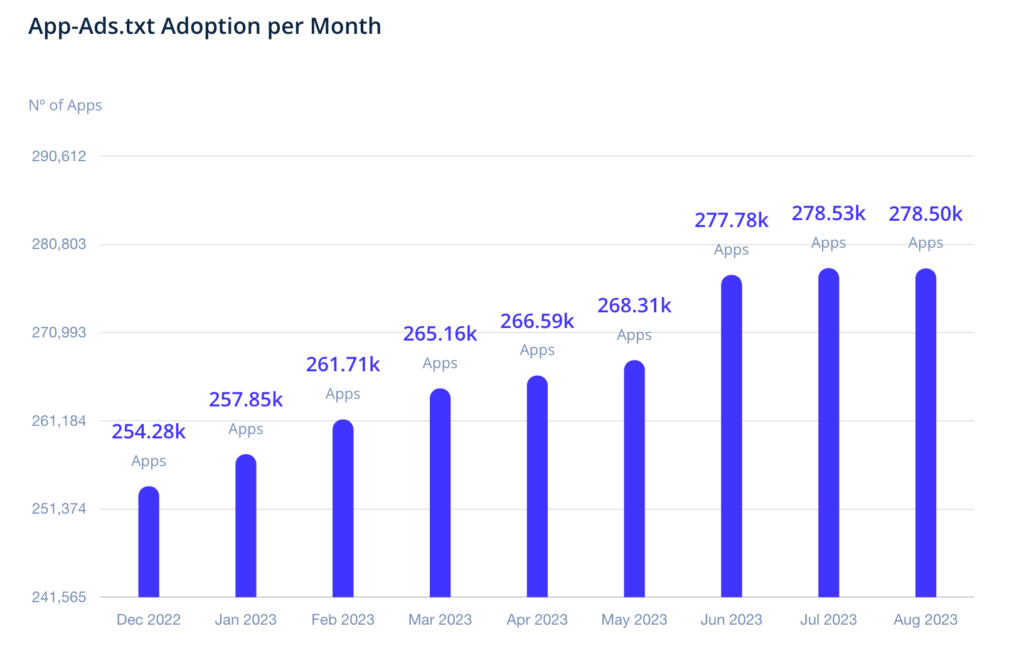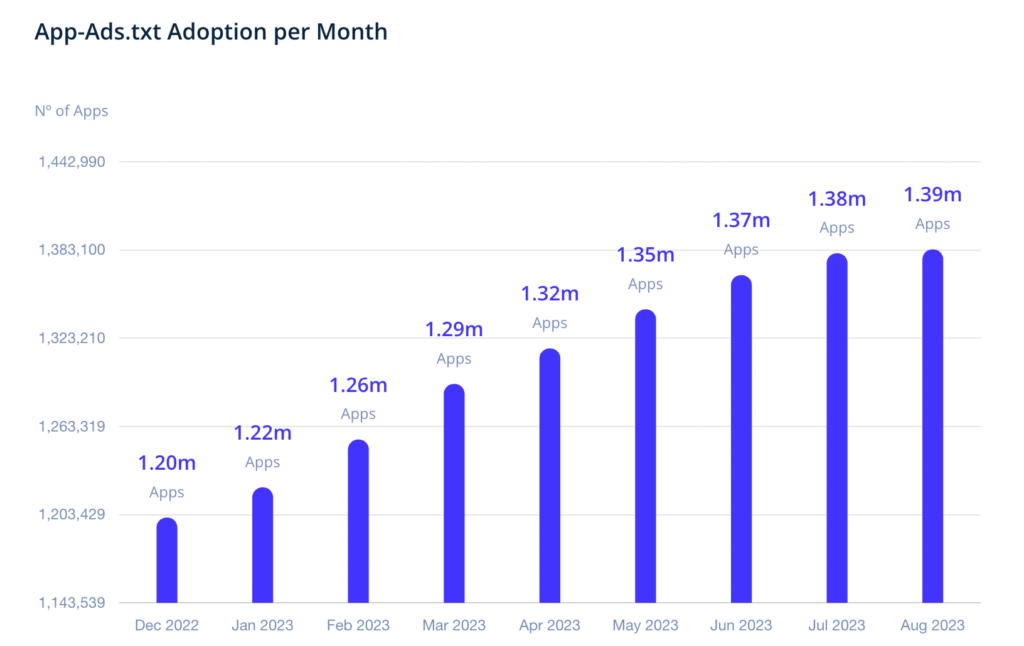App-ads.txt – What is It, And How to Implement It?
App-ads.txt file helps app publishers to prove to advertisers that the ad request originates from the app they own. App-ads.txt implementation is becoming a common practice, making ad verification more consistent and reliable.
In this article you will learn what app-ads.txt file is, why it is necessary and how to implement it to increase your brand trust and help reduce ad fraud!
The Origin of App-ads.txt
App-ads.txt (Authorized Sellers for Apps) is an IAB initiative to increase transparency and combat unauthorized inventory sales in the mobile app advertising ecosystem.
The “app-ads.txt” standard is an extension of the “ads.txt” (Authorized Digital Sellers) initiative, which was introduced to address similar issues in the web ad space. In the digital advertising world, programmatic ad buying is prevalent. Advertisers and agencies use automated systems to purchase ad space in real-time.
However, this openness also creates opportunities for bad actors to impersonate legitimate publishers and sell fake or unauthorized ad inventory, leading to ad fraud and revenue loss.
What is the ads.txt project?
IAB states that the ads.txt project aims to increase the transparency in the programmatic advertising ecosystem. It’s a simple and secure method that publishers and resellers can use to publicly declare the companies they authorize to sell their digital inventory.
This makes it harder for bad actors to profit from selling counterfeit inventory. As publishers adopt ads.txt, buyers will be able to more easily identify the Authorized Digital Sellers for a participating publisher, enabling brands to have confidence they are buying authentic publisher inventory.
What is App-ads.txt?
The IAB Tech Lab developed the app-ads.txt framework to ensure that ad space within mobile apps is only sold through legitimate and authorized channels. This framework serves several purposes, including protecting against ad fraud and making the supply chain management more efficient.

Source: Google AdMob
By implementing app-ads.txt, app developers gain greater control over who can sell ads on their apps, and advertisers can verify the authenticity of the ad inventory they are purchasing.
As a result, this can lead to increased revenue for both parties involved.
When app developers create and regularly update their app-ads.txt file, they take a crucial step to prevent potential losses in ad revenue due to ad spoofing and other fraudulent activities.
It helps establish a transparent and trustworthy advertising ecosystem that benefits both the developers and the buyers of ad inventory.
How Does App-ads.txt Work?
App-ads.txt files are openly accessible to various entities such as ad exchanges, supply-side platforms (SSP), buyers, and third-party vendors.
These files are hosted by developers on the root domain of their website, and they are linked from the app’s page on the Google Play Store or Apple App Store.
The app-ads.txt file contains a list of all the approved sources authorized to sell ad inventory for that particular app. This list is cross-referenced with the IAB system, which allows buyers to identify legitimate and authorized sellers.
Advertisers can verify that the unique developer ID in the ad request matches the corresponding ID listed in the app-ads.txt file when they want to display an ad within a mobile app.
They can do this by visiting the app store page for the specific app and locating the associated app-ads.txt file.
This ID verification process is crucial as it prevents malicious actors from attempting to fake ad requests under the mask of being an app. If the developer ID in their ad request doesn’t match the one in the app-ads.txt file, it signals that the ad request is not from an authorized source.
Role of app-ads.txt in ad verification
App-ads.txt plays a key role in ad verification by establishing a transparent and secure process for validating authorized mobile app ad inventory sellers. Listing only legitimate sellers in the app-ads.txt file is a powerful defense against ad fraud, safeguarding advertisers from falling prey to fraudulent activities.
Advertisers can cross-check the file to verify the identity of the authorized sellers and ensure that the ad inventory is sourced from trustworthy and verified channels. This heightened level of transparency fosters trust and confidence in the advertising ecosystem.
Additionally, app-ads.txt distinguishes between direct sellers and resellers, clarifying the roles of each party involved in the ad transaction.
App-ads.txt vs Ads.txt
| Ads.txt | App-ads.txt | |
| Purpose | Authorized Digital Sellers for websites | Authorized Sellers for mobile apps |
| Platform | Primarily for websites | Specifically for mobile apps |
| File Location | Placed on the root domain of the website | Placed on the app’s developer website and app store listing |
| Ad Inventory Type | Web-based ad inventory | In-app ad inventory |
| Seller Identification | Domain name and publisher account ID | Domain name and publisher account ID |
| Targeted Platform | Web-based advertising | In-app advertising |
| Initiative Support | Supported by the IAB | Supported by the IAB |
Decoding App-ads.txt: Key Elements and Syntax Explained
The app-ads.txt file comprises various lines for different ad networks and SSPs.
Each app-ads.txt record includes the following elements:
- Ad system domain–this refers to the primary domain name of the advertising system (or ad network) a buyer intends to use to access the publisher’s inventory.
For instance, if a publisher wants to authorize Google’s ad network to sell their ad space, they can specify “Google.com” as the ad system domain.
- Publisher account ID–this is a unique identification associated with the publisher’s or reseller’s accounts within the advertising system. It is used to identify the publisher’s account uniquely.
- Account type/relationship–this term describes the relationship between the publisher and the ad network. Publishers can specify vendors as “direct” or “reseller” based on whether the vendor uses third-party resellers to sell ad inventory.
Note: Publishers should refrain from adding any vendor to their app-ads.txt file until they or their partners have a connection or established relationship with them. This ensures that only authorized vendors are listed in the app-ads.txt file.
- Certificate authority ID–this is a unique identifier for the advertising system (or ad network) within a certification authority. It helps to distinguish the specific ad network within the larger advertising ecosystem.
Understanding the app-ads.txt syntax
The structure of both the ads.txt and the app-ads.txt file is straightforward.
Each line in the file represents a single authorized digital seller of the ad inventory. As already mentioned before–within each line, four fields of identifying information are included:
| FIELD | EXPLANATION |
| Field 1 (ad system domain) | The name or root domain of the seller that the publisher is authorizing to sell their ad inventory. |
| Field 2 (publisher account ID) | The publisher’s ID number within the seller’s platform. It uniquely identifies the publisher within the seller’s system. |
| Field 3 (account type/relationship) | The publisher specifies whether the relationship with the seller is “DIRECT” or “RESELLER.” This distinction prevents the sale of counterfeit ad inventory. |
| Field 4 (certificate authority ID) | This field is optional and contains the seller’s Trustworthy Accountability Group ID (TAG ID) number, which provides additional verification and accountability. |
All these fields are combined on a single line, separated by commas, to form a complete entry in the app-ads.txt file. This process is repeated for each authorized seller, listing them after the other until all the desired sellers have been authorized.

What does the “DIRECT” and “RESELLER” value mean?
“RESELLER” and “DIRECT” are values used to indicate the relationship between the publisher (content owner) and the authorized seller of their ad inventory.
- DIRECT
When the value is set to ”DIRECT”, it means that the publisher (content owner) directly controls the account indicated in field 2 of the app-ads.txt file.
For example, there is a direct business contract between the publisher and the ad system (seller) listed in field 1.The publisher has full control over their ad inventory, and the authorized seller sells the inventory directly to buyers on behalf of the publisher.
This designation is used when the publisher has a direct relationship with the seller, and the seller operates as a direct sales channel for the publisher’s ad inventory.
- RESELLER
On the other hand, when the value is set to ”RESELLER”, it indicates that the publisher has authorized another entity (reseller) to control the account indicated in field 2 of the app-ads.txt file
For example, the authorized reseller is permitted to sell the publisher’s ad space through the ad system listed in field 1. The publisher may not have direct control over the account in field 2, but they have given authorization to the reseller to manage and sell their ad inventory on their behalf.
This designation is used when the publisher uses third-party entities to sell their ad inventory, and these entities act as resellers between the publisher and the advertising system.
Benefits of Implementing App-ads.txt
Implementing app-ads.txt benefits the entire advertising ecosystem by ensuring transparency, reducing ad fraud, and creating a more secure and trustworthy environment for advertisers, app developers, and users.
Here are the 4 main benefits of app-ads.txt implementation:
1. Increased ad revenue
The trust and transparency provided by app-ads.txt can attract more advertisers, leading to increased demand for ad inventory. This can potentially result in higher ad prices and revenue for app developers.
2. Boosting brand trust and advertiser confidence
With app-ads.txt in place, advertisers can have more confidence in the placements of their ads, knowing that they are being shown on authorized and verified apps. This enhances brand safety and protects advertisers from inadvertently appearing on questionable or harmful content.
App-ads.txt is supported by major industry players (e.g., IAB, TAG, Google, Facebook) making it widely adopted and recognized.
3. Mitigating the impact of ad fraud
By only allowing authorized sellers to sell app ad inventory, app-ads.txt helps prevent ad fraud and unauthorized reselling of ad space. This ensures that advertisers’ investments are directed to legitimate channels.
4. Enhanced transparency
App-ads.txt provides transparency by publicly listing authorized sellers of app ad inventory. This transparency allows advertisers to verify the legitimacy of sellers, ensuring they are buying from trusted sources.
Implementation of app-ads.txt encourages app developers and publishers to follow industry best practices, such as establishing direct relationships with authorized sellers. This promotes a healthier and more legitimate ad ecosystem.
Implementing App-ads.txt: A Step-by-Step Guide
We’ve gathered and simplified the 6 main steps on how to implement app-ads.txt file:
1. Understand the requirements
Familiarize yourself with the concept of app-ads.txt and its purpose in preventing ad fraud and ensuring transparency in the ad ecosystem.
Your app-ads.txt file must be formatted as specified by the IAB in order to be verified. If you need additional help, review the Authorized Sellers for Apps specification.
2. Prepare your website
A developer website serves as a platform where users can gather information about your apps and other content. It also plays a role in determining the ownership of an app according to the app-ads.txt standard.
It’s essential that your developer website is linked to your listings on Google Play or the App Store.
Note: if you haven’t set up a website for your app, it’s necessary to create one before proceeding to establish an app-ads.txt file.
Once your developer website is in place, make sure to update your app’s listing on the app stores. This update should include a link to your website as the contact URL for developers.
2.1. Add your developer website in your app store listing
For Google Play: Add the website URL in the contact information of your app listing:
- Sign in to your Play Console.
- Select an app.
- On the left menu, click Store presence, then Store listing.
- Hover to Contact Details.
- Add your developer website URL.
For Apple App Store: Add your developer website in the marketing URL field of your store listing.
3. Obtain seller information
Gather the necessary information for each authorized seller, including their name or domain, your publisher ID within their platform, and the type of relationship you have with them (direct or reseller).
Each seller gets their own line in your file. Some sellers might provide an already made code of app-ads.txt for you.
4. Create the file
Using a text editor (e.g., Notepad on Windows or TextEdit on macOS), create a new plain text file. Each line in the app-ads.txt file represents an authorized seller of your app’s ad inventory.
For each authorized seller include four fields separated by commas in the following format:
- Network name, publisher/account ID, relationship type (direct or reseller), TAG ID (optional)
Repeat that process for each seller you have, starting each seller on a new line in the document.
5. Upload the file
Add the authorized seller entries to the app-ads.txt file. Save the app-ads.txt file with the correct information. Upload the file to the root directory of your website or server, making it publicly accessible.
When your app-ads.txt file is complete, you need to get it onto your developer website.
Each content management system (CMS) has a slightly different process for creating new pages, so follow the process your CMS provides for creating a new page at the root domain level.
6. Verify the file
To make sure your app-ads.txt file is working correctly, first you need to double-check that the app-ads.txt file is correctly formatted and accessible through a web browser.
You can access it by entering your website and adding /app-ads.txt at the end of the URL. Your app-ads.txt file should appear as plain text on that page.
In the end, the URL of your file should look like this:
- https://www.example.com/app-ads.txt
Monitoring and Maintaining Your App-ads.txt File
If the app-ads.txt file is implemented incorrectly, then the buyer’s crawler won’t be able to dissect the seller’s information from the app store and the buyer won’t be able to confirm if the seller is authorized to sell the app’s inventory.
It can lead to a revenue loss for both the publisher and the seller, because the buyer won’t bid for any impressions coming through that seller.
That’s why it’s essential to regularly update the app-ads.txt file as needed, especially when authorizing new sellers or making changes to existing ones.
App-ads.txt file warnings and error messages
If a publisher is using Google Ad Manager (GAM) or AdMob, they can easily check for the following errors and warnings in their account.
It’s important to visit the app-ads.txt setting regularly to see if anything has changed, or to respond to error messages or notifications that you receive.
For example:
- A red error icon appears if a row has incorrect formatting that will stop parts of the app-ads.txt file from working as expected.
- A yellow warning icon appears if a row contains other issues that won’t necessarily stop the app-ads.txt file from working.
- A green icon appears if a row doesn’t contain any issues that would stop the app-ads.txt file from working.
- A grey icon appears if no app-ads.txt file is found for the app.

Source: Google AdMob
App-ads.txt implementation checklist
We’ve gathered the 6 most important points you should double-check when implementing the app-ads.txt file to make sure that everything works correctly:
- List your developer URL on all app stores distributing your app.
- Ensure that you implement app-ads.txt on the same developer URL that is listed on the app store.
- If you have multiple developer URLs across apps, ensure that app-ads.txt file is implemented on all developer URLs and all your apps list the same developer URL on the app store.
- Make sure that the app-ads.txt file has been implemented in the root domain (e.g., https://example.com/app-ads.txt).
- The file name should always be app-ads.txt.
- Ensure that the file format is .txt.
Impact of App-ads.txt on the Ad Ecosystem
App-ads.txt has significantly impacted the ad ecosystem by introducing greater transparency and trust. With publicly accessible files listing authorized sellers for mobile app ad inventory, it allows advertisers to verify the legitimacy of ad sources, reducing ad fraud and improving inventory quality.
This framework streamlines the supply chain, granting publishers more control over ad sales and ensuring ad space is sold through legitimate channels.
As a result, app developers experience increased revenue potential due to higher advertiser confidence.
App-ads.txt encourages best practices, fosters standardization, and enjoys broad industry support, contributing to a more reliable and cooperative advertising environment for all stakeholders in the digital advertising ecosystem.
How App-ads.txt Shapes the App Industry?
App-ads.txt has emerged as a transformative force, reshaping how stakeholders interact with ad inventory and addressing critical challenges such as ad fraud and transparency. This standardized solution, endorsed by industry giants like the IAB, can revolutionize the ad industry by establishing a new era of credibility, security, and collaboration.
We’ll further explore how app-ads.txt impacts two of the largest app distribution platforms–the Apple App Store and Google Play Store.
App-ads.txt within Apple App Store
Data from August 7, 2023, shows that in the Apple App Store, app-ads.txt is a beacon of enhanced transparency and trust. The implementation of app-ads.txt has seen a 15.52% adoption rate among apps, translating to 278,504 out of 1,794,251 apps.

Source: 42Matters
This adoption trend indicates a growing significance of transparency in the ad ecosystem, where app developers are taking proactive measures to authenticate the legitimacy of their ad inventory.
Moreover, the implementation rate soars to an impressive 49% among the top 1,000 apps, underlining the critical role that industry leaders play in advocating for a more secure and trustworthy advertising environment.
App-ads.txt within Google Play Apps
Data from August 7, 2023, shows that on the Google Play Store platform, app-ads.txt is making waves of change–36.28% of all apps, totaling 1,385,813 out of 3,819,848 apps, have embraced this standard to ensure ad transparency and security.

Source: 42Matters
The adoption rate is even more prominent among the top apps, where 72.3% of the top 1,000 apps have implemented app-ads.txt.
This emphasis on adoption among top-ranking apps signifies a strong commitment to combat ad fraud and enhance transparency, reflecting a collective effort to safeguard the interests of both advertisers and users.
Conclusion: App-ads.txt is a Necessity, Not an Option
App-ads.txt is a dynamic force shaping the ad industry by instilling accountability, reducing fraud, and fostering collaboration. It brings better security to mobile ads. As more apps on platforms like the App Store and Google Play adopt this standard, transparency and trust in the ad world are growing.
This means fewer fake ads, making the ad space safer. Advertisers, publishers, developers, and networks are teaming up to fight fraud together, and this teamwork is expected to continue.
As technology advances, it will become even better at catching fake ads, ensuring ads are more honest and trustworthy. This all adds up to a future where mobile ads are more secure, honest, and dependable.
We strongly suggest you to follow the best practices and maintain an app-ads.txt file to maximize revenue and safeguard your app against certain types of fraud!
Frequently Asked Questions
What happens if I don’t implement app-ads.txt?
App-ads.txt file helps to establish a transparent and trustworthy mobile advertising ecosystem that benefits both the developers and the buyers of ad inventory. You gain more control over who’s allowed to sell ads on your app and it helps prevent counterfeit inventory from being presented to advertisers.
How often should I update my app-ads.txt file?
It’s essential to regularly update the app-ads.txt file as needed, especially when authorizing new sellers or making changes to existing ones.
Can I use the same app-ads.txt for multiple apps?
Yes, you can use the same app-ads.txt file for multiple apps as long as the authorized sellers listed in the file are applicable and authorized for all the apps.
Are there any tools to help implement and monitor app-ads.txt?
Currently there are plenty of ads.txt file validators online, but not so many easily available for app-ads.txt. However, if you have a GAM account you can use their ads.txt management feature to validate and troubleshoot your app-ads.txt file.
What’s the difference between ads.txt and app-ads.txt?
Both serve the same purpose of increasing trust and reducing ad fraud in the advertising ecosystem, but the main difference is that ads.txt is primarily used for web advertising while app-ads.txt file for mobile advertising.


